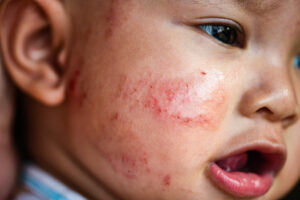Every year there are deaths from rare food allergies in children. The Children’s Hospital of Philadelphia analyzed electronic health records of more than 200,000 children. Medical News Today reported about this research from Philadelphia. They found that eosinophilic esophagitis (EoE), which is a rare food allergy was more common than previously thought. In addition, previous researchers thought it was more common in white people. However, the new research with larger numbers showed that it is more common in non-white people. It was published in Pediatrics on July 25, 2023.
Key findings
The following findings were published.
- Physicians found the incidence of allergic disease was 10.3%. The peak diagnosis was at age 4 months.
- Atopic dermatitis occurred at a rate of 4% at 13 months.
- IgE mediated food allergy was 20.1% with a peak diagnosis at 13 months
- Asthma occurred with a frequency of 20.1% and the peak diagnosis was at 13 months of age
- Allergic rhinitis was at 19.7% and mostly found at age of 26 months
- Eosinophilic esophagitis was diagnosed in 0.11% cases with a peak diagnosis of 35 months
- The most diagnosed immunoglobulin E–mediated food allergies were peanut (1.9%), egg (0.8%), and shellfish (0.6%)
- 4% of children had two or more allergic conditions like asthma and allergic rhinitis and any other allergic condition.
More information on eosinophilic esophagitis
Although this condition is rare, it is very important to diagnose it early, when a patient is suffering from it. Here is some background information about it. With this condition chronic inflammation of the esophagus can lead to scarring and cause esophageal strictures.
The physician will refer the patient to a gastroenterologist and also to an allergist. The gastroenterologist can do an esophagoscopy and biopsy. The allergist will do skin testing against a panel of foods. When the allergist identifies the food that the patient reacts to, the patient and parents can cut out this food. After a few weeks the eosinophilic esophagitis will disappear.
Conclusion
A new study of 200,000 children has determined that allergies in children are much more common than previously thought of. Researchers also found that there are also more non-white children who suffer from allergies than was the previous assumption. The allergist plays a pivotal role in the identification of the underlying allergies. This is particularly important in the case of eosinophilic esophagitis, which was the diagnosis in only 0.11% of all cases with allergies. However, when the physician does not work up these cases properly, they can lead to esophageal strictures. Allergists can identify the underlying food allergy and help prevent stricture formation. As always, an early diagnosis and treatment are most important.








Pingback: cover LED indicator lights at night